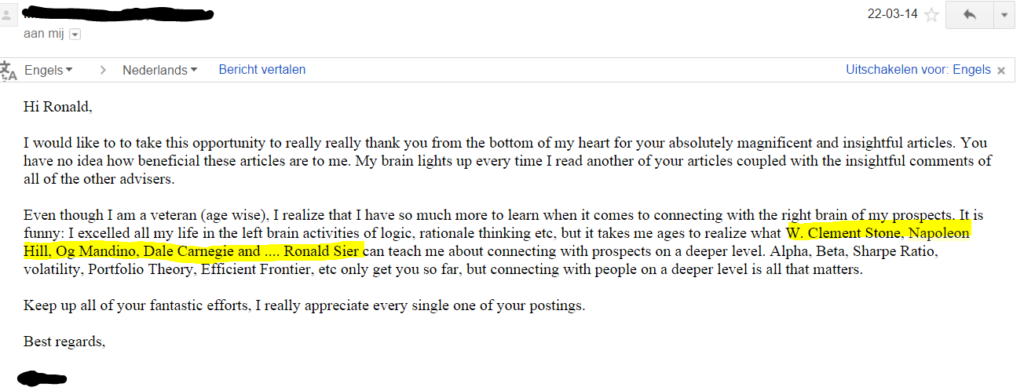After all, that’s the dream, right?
We want to quit our jobs, spend more time with our families, and finally have time to do the “real” work. We want our financial planning to help people, to inspire them, to change them from the inside out.
It’s a modest dream, a dream that deserves to come true, and yet a part of you might be wondering …
Will it?
Do you really have what it takes to be a self-employed financial planner? Is it realistic to think you can make enough money from this to quit your job, or is that just silly? Can you really expect people to fall in love with what you do, or is that just wishful thinking?
Sure, it’s fun to dream about your financial planning service taking off and changing your life, but sometimes you wonder if it’s just that: a dream. This is the real world, and in the real world, dreams don’t really come true.
Right?
Well, let me tell you a little story…
How I Quit My Job
When you ask people if you should quit your job, they mostly say something like: “Why don’t you quit your job and follow your heart? You’ll be fine, you have tons of experience and all the qualifications. Don’t worry, you’ll make it”.
But I was never a fan of this “strategy”. Despite taking calculated risks, I don’t believe people should ever jump off a cliff without a parachute and figure out how to build that parachute on the way down.
I remember telling my plans to quit my job to another blogger, and he said something like: “You already have a parachute, why don’t you use it?”
My parachute?
It’s my blog. I actually don’t remember much about the start back in 2013. But I do remember the hours I put into it. I spent most of my time in my tiny, tiny attic. Writing, writing and writing.
Boy, it was hard. The English language is tough when you haven’t written in decades. And on top of that: I was a really bad writer.
For months I endured the pain of writing really bad stuff and thinking: “Why on earth am I doing this?”
But for some reason, I pursued. I pursued because it felt right.
And looking back, I didn’t just tinker around with writing. I dedicated myself to it. Every weekend, Monday-night, and Tuesday-night, I did the work. I didn’t watch television. I didn’t see my friends, I didn’t exercise. Every spare hour, I was writing, reading, and connecting with other writers and bloggers. Nothing else.
And here’s what happened.
Within a year my top article hit 59,000 readers. Within two years 2,000 financial planners subscribed to my blog. And the craziest things happened to me. People from all over the world started asking me to speak at their conference, contribute to their blogs, and wanted to meet with me in person.
And that’s actually the beginning of the story…
Have you ever woken up one day and realized you secretly don’t like the work you are doing?
Because the compliance is horrible. Because the rules are flooding you. Because your organization doesn’t care about you anymore?
While in the meantime, people from all over the world (people you haven’t even met before) cheer when you write a little piece of text, give compliments, and even compare you with one of the most inspiring writers in history.
Now, that is fantastic, right?
Well, not to everyone.
Last year, compliance officers advised me to reduce my blogging. What they really told me is to stop caring about our beautiful profession …
So I asked myself:
Is it so bad to explore our beautiful profession by digging a little bit deeper? Is it so bad to take a little leap (in my spare time)?
I asked myself why? Why don’t they (try to) understand what I’m trying to do? For a short period of time, I tried to answer that question. Fooling myself that I was going to get the answer. A couple of days later, I decided to quit my job.
The only problem: at that time I didn’t have a rock solid plan to earn a decent living if I quit. I didn’t have a killer-strategy to pay my mortgage and other bills.
So, there was work to do. After all, I’m a financial planner. It would be quite stupid if I didn’t have a plan …
How I Took the Leap
Looking back, I already took it. Back in 2013, when I started my blog.
I already decided in 2013 that my job wasn’t to focus on Assets under Management or to produce as many plans as possible.
That wasn’t my job anymore. My job was to search for a spark. Because buried deep down inside, people have hidden fears, dreams, desires and goals, and every once in a while, those emotions will leap to the surface, giving a clue about how to bring them back.
You’ll see when you pay close attention to the people you serve.
One moment, their eyes are dull and glassy. The next, they’re shining with emotion. One moment, their skin is gray and waxy. The next, it’s a glowing pink. One moment, their body is stiff and awkward. The next, it’s full of vitality.
It’s like watching people come to life, although that’s not exactly true, of course. They were always alive. It’s like they just forgot for a while, and they need someone to remind them.
I wanted that “someone” to be me.
And you might think: that’s quite foolish Ronald. Searching for a spark doesn’t pay the bills.
And you’re right! But what might surprise you is I left out a piece of the story.
It’s a piece about money. Because a lot of people think I’m a fool. Because to most of the world, having a blog like this is a joke. A joke that costs a lot of spare time. It isn’t a career and it isn’t a way to make money and it isn’t a tool to do work that matters.
It’s a hobby, a diversion, a fad that’ll come and go.
Try telling your family or friends or coworkers you want to quit your job and make money blogging. They’ll smile politely and ask, “Does anybody really make money from that?”
I’m hesitant to say this, but …..
I earned $21,000 from my blog.
How?
People paid me for my online teaching.
Getting paid feels good. Because when you run out of cash, the euphoric feeling you get when people say nice things about you, will soon turn to panic if you can’t pay your bills.
So when I decided to quit my job, the next thing I wanted to know was if I could earn money on my own. All by myself. Without any help.
The result?
I did it. I earned my own money.
That was the most reassuring feeling I’ve had in a very long time. The thought that I could earn money without the help of someone else. People paid me, because of me. Not for someone else. Just for me.
It made me feel confident to take the leap. And I did.
How to Get Paid to do Financial Planning that Matters
So, here I was. I quit my job. I earned some money.
Now what?
The most important thing I struggled with was how I was going to earn money. I mean, money is the lifeblood of every entrepreneurs’ business, right? I figured that if I didn’t earn any money, my new business wouldn’t be worth anything.
But is this really true? Is money really the lifeblood of an entrepreneur’s business?
Because when I think back to February 2013, I didn’t think about earning money from my blog. I started it because I loved what I was doing.
The irony?
Within two years I did earn money from my blog. Not because I intended to do so from the beginning. No, because I was doing things I loved, and people paid me for that. So, I asked myself:
Why should I spend my time doing self employed financial planning, just to get paid?
Because the pitfall of this idea is that, in order to monetize my work, I’ll probably corrupt it, taking out the magic in search of dollars. That’s why I’m continuously asking myself why I shouldn’t spend my time doing financial planning, even if I don’t get paid? Is it ok to do financial planning, even if I don’t get paid in money?
Because maybe I get paid in community. Maybe I get paid in the psychic benefit of making a difference. After all, that’s the benefit I “earned” when starting my blog. And the beauty is, that not too long after starting, I actually got paid in money.
Will the same strategy be possible for my brand new financial planning service?
Now, I’m quite sure that 95% of financial planners who read this, will wrestle with this idea. Because starting a business with the strategy of NOT getting paid for your work (at first), seems like the world has turned upside down.
But let’s think about this. Wouldn’t it be a great strategy to build a connection with your audience first? So that people get to know, like and trust you?
Imagine if you had a direct connection with hundreds, maybe thousands of prospects for your financial planning service? How would you feel, knowing that every time you push send, you already know that you are reaching lots of people you want to serve?
How to Build Your Audience (and Get Paid)
I’ve learned that there is no better way to build a responsive audience for my (future) business, than with the classic workhorse of the internet, the email list.
Many planners unfortunately don’t know about email marketing. And to some it might even strike as “old-fashioned”. More fashionable venues like social media and mobile marketing get all the attention. And some marketeers will even try to tell you that email marketing doesn’t work for our profession.
Unfortunately, reality doesn’t agree. In fact, with a strong and smart approach, email marketing is more powerful than ever. I know, because I’ve build this blog from scratch. From zero to 2,350 financial planners from all over the world.
So, why is email so powerful when building your audience?
Because it moves the conversation about your financial planning service to a more personal environment – the inbox of your prospect. Email provides you the most direct line of communication for conversion to sales.
So, what makes email marketing so effective?
- Email marketing is – by far – the most cost effective way of promotion
- By consistently offering valuable content, you build loyal followers
- More followers drives repeat traffic through referrals and word-of-mouth
- You can track email data easily and watch your response rates as they climb or fall
- Higher engagement means higher conversion rates that boost your bottom line
What makes email content work?
Via copyblogger.com:
All of us are too familiar with email newsletters that waste our time, pitches that annoy us, and downright spam. Those don’t work. What works is value exchange – your valuable information for your prospect’s valuable time. Your subscribers need to know they can trust you … that you’re not a soulles self-promoting spam-bot.
Not convinced yet?
I understand. But I want to help you. I want to help you to understand the power of email by giving you 5 Simple Email-Templates That Will Make Your Life a Whole Lot Better
This sounds crazy, but science proves that when you send 5 simple emails, it can increase your happiness big time.
Now, I’m about to give you the free PDF. The only thing I would like you to do for me is to answer this question:
What’s holding you back when it comes to using email marketing for your financial planning service?
Please, answer this question by leaving your comment – here below – and you’ll instantly receive a free PDF with 5 Simple Email-Templates That Will Make Your Life a Whole Lot Better.
After reading this free PDF, you’ll understand the power of email. Trust me.
Thank you for your comment.
Let’s make financial planning matter,
Ronald Sier




